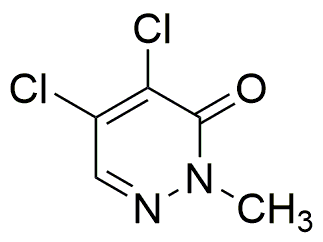4,5-Dichloro-2-methyl-3(2H)-pyridazinone is widely utilized in research focused on:
- Agricultural Chemicals: This compound serves as a key ingredient in herbicides, helping to control unwanted plant growth effectively while minimizing harm to crops.
- Pharmaceutical Development: It is explored for its potential in developing new medications, particularly in targeting specific diseases due to its unique chemical structure.
- Analytical Chemistry: Used as a standard reference material in laboratories, it aids in the calibration of instruments and validation of analytical methods.
- Material Science: This chemical is investigated for its properties in creating advanced materials, contributing to innovations in coatings and polymers.
- Environmental Studies: It plays a role in research assessing the impact of chemical pollutants, helping scientists understand and mitigate environmental risks.
Información general
Propiedades
Seguridad y normativas
Aplicaciones
4,5-Dichloro-2-methyl-3(2H)-pyridazinone is widely utilized in research focused on:
- Agricultural Chemicals: This compound serves as a key ingredient in herbicides, helping to control unwanted plant growth effectively while minimizing harm to crops.
- Pharmaceutical Development: It is explored for its potential in developing new medications, particularly in targeting specific diseases due to its unique chemical structure.
- Analytical Chemistry: Used as a standard reference material in laboratories, it aids in the calibration of instruments and validation of analytical methods.
- Material Science: This chemical is investigated for its properties in creating advanced materials, contributing to innovations in coatings and polymers.
- Environmental Studies: It plays a role in research assessing the impact of chemical pollutants, helping scientists understand and mitigate environmental risks.
Documentos
Hojas de datos de seguridad (HDS)
La SDS proporciona información de seguridad completa sobre la manipulación, el almacenamiento y la eliminación del producto.
Especificación del producto (PS)
La PS proporciona un desglose completo de las propiedades del producto, incluida la composición química, el estado físico, la pureza y los requisitos de almacenamiento. También detalla los rangos de calidad aceptables y las aplicaciones previstas del producto.
Certificados de análisis (COA)
Busque certificados de análisis (COA) ingresando el número de lote del producto. Los números de lote y de partida se pueden encontrar en la etiqueta de un producto después de las palabras "Lote" o "Lote".
Número de catálogo
Número de lote/lote
Certificados de origen (COO)
Este certificado de origen confirma el país en el que se fabricó el producto y también detalla los materiales y componentes utilizados en él y si se deriva de fuentes naturales, sintéticas u otras fuentes específicas. Este certificado puede ser necesario para cumplir con las normativas aduaneras, comerciales y regulatorias.
Número de catálogo
Número de lote/lote
Hojas de datos de seguridad (HDS)
La SDS proporciona información de seguridad completa sobre la manipulación, el almacenamiento y la eliminación del producto.
DownloadEspecificación del producto (PS)
La PS proporciona un desglose completo de las propiedades del producto, incluida la composición química, el estado físico, la pureza y los requisitos de almacenamiento. También detalla los rangos de calidad aceptables y las aplicaciones previstas del producto.
DownloadCertificados de análisis (COA)
Busque certificados de análisis (COA) ingresando el número de lote del producto. Los números de lote y de partida se pueden encontrar en la etiqueta de un producto después de las palabras "Lote" o "Lote".
Número de catálogo
Número de lote/lote
Certificados de origen (COO)
Este certificado de origen confirma el país en el que se fabricó el producto y también detalla los materiales y componentes utilizados en él y si se deriva de fuentes naturales, sintéticas u otras fuentes específicas. Este certificado puede ser necesario para cumplir con las normativas aduaneras, comerciales y regulatorias.


